Janggi (장기): Korean Chess
The variant of chess played in Korea is written as 將棋 in Hanja and spelled as 장기 in Hangul. The official romanization of its name is Janggi. W. H. Wilkinson and H. J. R. Murray both romanized the name as Tjyang-keid. It has also been transliterated as Changgi or Jangki. The meaning of the name is Generals' Game, and its Hanja name is identical to Shogi's Kanji name. The first character 將 (jang) means a general, as in the military rank, and the second character 棋 (gi) means strategy board game. This same character is also used in the name for Chinese Chess.
The game is similar enough to Xiangqi, the Chinese form of Chess, that it can be played with the same equipment, though it still differs from it in various ways. As is elaborated on further in The History of Chess Variants, it appears likely that Chess began in India and eventually made its way to Korea by way of China. This makes sense geographically, because China borders each one at a different end. It also makes sense given the strong influence that the various Chinese dynasties have long exerted over the kingdoms of the Korean peninsula. Being much larger, China has normally been stronger militarily, and it has been a major influence on Korea economically, politically, religiously, and culturally. Looking at the games themselves, both portray the pieces with Chinese characters, not with Korean Hangul, which suggests that the Chinese game came first. Also, Chinese Chess is more similar to the Indian game of Chaturanga than Janggi is, which suggests that it was transitional between them. Nevertheless, prior origin does not make one game better than the other. In some respects, Korean Chess may be considered an improvement on Chinese Chess.
Board, pieces and opening setup
Korean Chess may be played with a Xiangqi set if that's what you have on hand, but there are differences between the equipment used for this game and for the Chinese game.
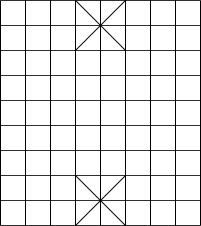
Like the board for Xiangqi, the board for Janggi is a grid of nine by ten lines, and at each end, there is a 3x3 palace, demarcated by diagonal lines. The vertical lines are the board's files, and the horizontal lines are the board's ranks, for the pieces go on the intersections of the lines instead of in the squares formed by the lines. Unlike the board for Xiangqi, the files are further apart than the ranks, adding width to the board, and the files are represented by unbroken lines, since this game has no river.
Traditional pieces are octogonal counters, each with a Hanja character for the piece printed or engraved on it. Pieces may be wood or plastic. They may be colored blue and red like in Xiangqi or green and red. Unlike Xiangqi pieces, which are uniform in size, Janggi pieces come in three sizes: the largest size is used for the General (King), the medium size for the the Chariots (Rooks), Cannons, Horses (Knights) and Elephants, and the small size are the Guards and the Soldiers (Pawns). The two sides are named for the different characters that appear on each side's General. The red side is called Han (漢), and the green or blue side is called Chu (楚). These names reflect the Chinese origin of the game, since Chu and Han were Chinese kingdoms who fought each other for control of China around 206-202 BCE. Han's pieces normally include some of the same characters used for pieces in Xiangqi. Chu's pieces normally use cursive versions of the characters that appear on the red pieces, though they do use different characters for the Pawns. The player to move first is Chu.
The opening setup is shown below in two different variations. The first shows the sort of equipment Koreans usually play the game with, and the second shows something that should be more recognizable for western players of Chess, illustrating that the game is not as different from western Chess as it might at first appear. From left to right on each player's first rank are a Chariot, a Horse, an Elephant, a Guard, an empty space, a Guard, an Elephant, a Knight, and a Chariot. The second rank just has the General in the center file. This is the one difference in setup from Xiangqi, which places this piece on the first rank. The third rank has two Cannons, each placed on the second file from its side of the board. The fourth rank has five Pawns, spaced so that no two are adjacent.
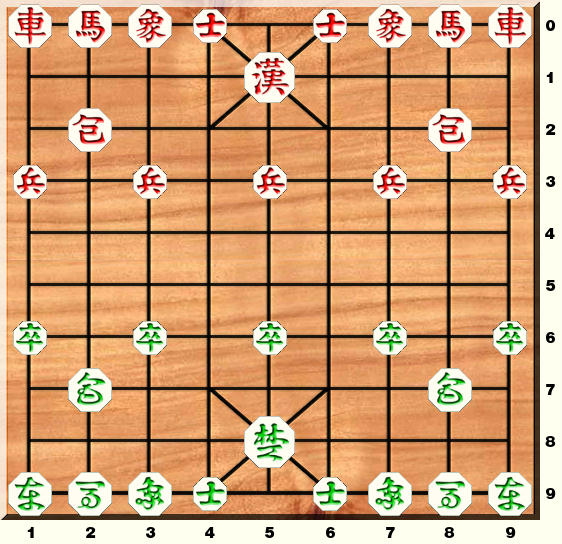
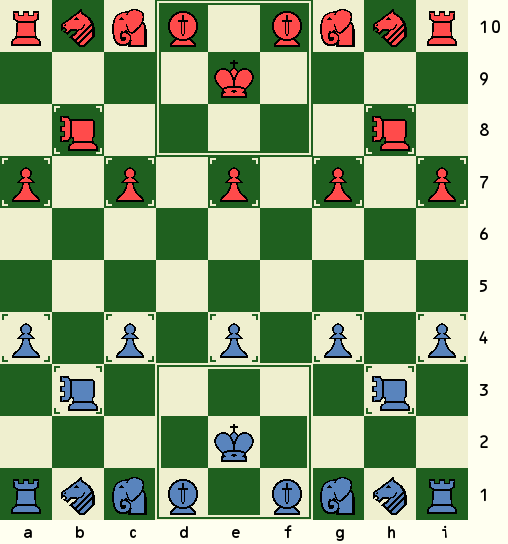
Before play commences, though, each player has the option of altering the positions of his Horses and Elephants. Han, the player to move second, gets the first choice. He may swap a Horse and an Elephant on one side or on both sides, though not between sides. When done, each side should still have a Horse and an Elephant on it. Afterwards, Chu, who moves first, may do likewise. With a physical set, this may be handled by having the Han player place his pieces on the board first, followed by the Chu player placing his pieces second. However it is done, this gives each side one of four possible starting positions, and it gives the game as a whole 16 possible starting positions. But there are not 16 mathematically distinct starting positions. Four are distinct, and six are each symmetric with one of the other six. A position is symmetric to another if you can put a mirror on the side of one and see the other. The significance of this is that mathematically equivalent games can be played from each position. All the games that can be played from one are just mirror images of the games that can be played from the other. This reduces the number of mathematically distinct starting positions to ten.
Pieces
Although Janggi is played with all the same pieces as Xiangqi, only Horses move the same as they do in Xiangqi. Every other piece has different powers of movement. One difference that affects every piece except the Horse and Elephant is that diagonal movement is allowed along the diagonal lines of the palace. Without reference to the lines, the rule is that these pieces may move diagonally within the palace in directions that pass through the center. What this means for each piece depends on how it otherwise moves. Besides that, the Elephant, Cannon, and Pawn have different powers of movement than in Xiangqi. Details follow.
General / King
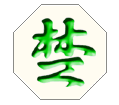
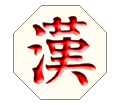
The two Generals are called Chu (楚) and Han (漢). In North Korea, the red General is known as Jang (將), meaning general, and the other one is known as Gwan (官), meaning minister. The General moves only within the 3x3 palace that lies at the center of each player's first three ranks. It may move one space along any of the lines in the palace, though it may never exit the palace. Without reference to the lines, the rule is that it may move one space in any orthogonal direction so long as it stays within the palace, or it may make any one space diagonal move that either begins or ends in the middle of the palace. So, from the center, it can move one space in any direction, but from any other space in the palace, it has only three possible moves, these being to the center space or to any orthogonally adjacent spaces.
One further restriction on the movement of the General is that it should normally avoid facing the opponent's General along the same file with nothing in between them. The one exception to this is that the player who is behind in material may move his General to face his opponent's General, and if the opponent does not interpose a piece on the same file or move his General to another file, the game ends in a draw. This exception also allows the General of the player who is behind to capture a checking piece that is protected only by the other General.
Contrary to what this page has previously said, a player who does this does not irrevocably forsake the right to checkmate the other side.
This is gone over in more detail further below.
Counsellor / Guard


The name of Counsellor is the more accurate translation of the Korean name (sa), though Guard is a popular name, because it describes the function of the piece in the game, which is to guard the General. Like the General, the Guards move one space along any of the lines of the palace, and they are not allowed to exit the palace. Without reference to the lines, the rule is the same as it is for the General. Unlike Xiangqi, where these pieces move differently from each other, the General and Guard have the same powers of movement in Janggi. The only difference is that Guards have no ability to check the opponent's General.
Chariot / Rook
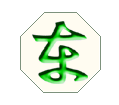
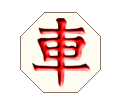
With a couple exceptions, the Chariot (cha) moves exactly the same as the Rook in Chess. The first exception is that there is no castling in Janggi. The second is that it can move along any lines on the board. This gives it the power to move diagonally within the palace. Since the diagonal lines in the palace do not extend beyond it, any diagonal move of the Chariot must begin and end within the palace.
Without reference to the lines, the Chariot can move any number of spaces in any orthogonal direction, so long as its path is clear, and it ends its move on an empty space or a space occupied by an enemy piece. Within the palace, it may move as a Chess Bishop so long as this move starts from a corner or the center space of the palace, and it ends on a corner or the center space of the palace. So, from one corner to the other, it may move two spaces as a Bishop, and from the center, it may move one space as a Bishop.
Cannon

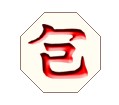
The Cannon (po) moves like a Chariot, except that it must hop over a single intervening piece, called a screen, during the course of its move, which may be any piece except another Cannon. If you're familiar with the Cannon from Xiangqi, this piece both moves and captures in the same manner that the Xiangqi Cannon captures, though with the additional restrictions that it may not hop over another Cannon, and it may not capture another Cannon. At the beginning of the game, the Cannons are all unable to move, because the first piece it can reach in any orthogonal direction is another Cannon, and Cannons cannot hop over other Cannons. An intervening piece must move into the path of a Cannon before it can move.
Just like the Chariot, the Cannon may move diagonally along the diagonal lines of the palace. Because its move always requires an intervening piece to hop over, the only diagonal moves a Cannon can make in the palace are from one corner to the opposite corner.
Horse / Knight
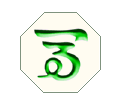
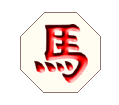
The Horse (ma) moves just the same as the Horse does in Chinese Chess. It makes a two-step move that begins with an orthogonal move and continues in one of the two diagonal directions that take the piece further away from the space it began on. When there is another piece on the first step of its move, its moves that would pass through that space are blocked. When unimpeded, it can reach the same spaces as the Knight in Chess can. Unlike that piece, it cannot leap directly to its destination, and it is blockable on the first step of its move. Unlike Rooks, it cannot stop on the first step of its move. It must make both steps or not move at all.
Elephant
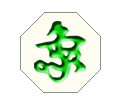
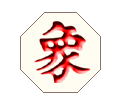
The Elephant (sang) moves like the Horse, except that it steps three spaces instead of just two. Its first two steps are just like the two steps of the Horse. It first moves orthogonally, then it moves diagonally outward. It completes its move by moving one more space in the same diagonal direction. Like the Horse, it may be blocked. Since its move takes three steps, any potential move may be blocked on one of two different spaces. So, to reach its destination, it must move along a clear path. When unimpeded, it may reach the same spaces as the fairy chess piece known as the Zebra.
Unlike the Elephant in Xiangqi, it is free to move to the other side of the board. Janggi has no river, and so has no rules concerning the river. Another difference from the Xiangqi piece is that the Korean Elephant may potentially reach any space on the board through a series of moves. On a checkered board, its move would always change color like the Knight in Chess does.
The next diagram illustrates the movement of the elephant. Note that the positions that are passed by must be empty.
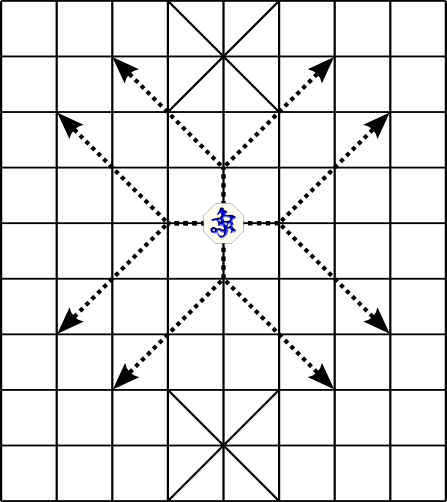
Soldier / Pawn

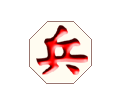
The Soldier (beyong for red, and jol for blue/green) moves one space forward in the same file or sideways in the same rank. This is the same move as the Xiangqi Pawn gets when it crosses the river, but there is no river in this game, and Pawns always have the power to move sideways. Like the Pawns in Chess and many other variants, these Pawns may not move backwards. But unlike the Pawns in Chess, Janggi Pawns are not divergent pieces. They always move and capture in the same way.
Object
Like Chess, Janggi is won by checkmating the opponent's General. There is an exception to this, though. When one player is behind, he may check his opponent's General with his own by moving it to the same file when nothing is in between them. For this purpose, the General is understood to have the attacking power of a Rook. So long as both Generals are in the same file, and nothing stands between them, the General that just moved will be checking the other one. However, a checkmate in which a General is the checking piece counts as a draw for both sides, not as a win for the player who delivers the checkmate.
Wilkinson, Murray, and Gollon all report that a player with a lone King (General) may pass his turn by turning the piece over. Contrary to this, Pritchard says A player may pass his turn, hence no stalemate or zugzwang.
Since Wilkinson is Murray's source, and Murray is Gollon's, their agreement on this should not be understood to imply that their interpretation of the rule is more reliable. However, Pritchard has sometimes gotten the rules of games wrong, and Wilkinson is the only one here who actually lived in Korea. So, Wilkinson should probably be considered more trustworthy on this matter. Contrary to both claims, Wikipedia reports that players may pass when none of their pieces can legally move. The Korean Wikipedia, which may be more authoritative on this subject than the English, seems to corroborate this. In a list of differences with Xiangqi, it says of Janggi, 마땅히 움직일 것이 없을 땐 한수 쉬어 상대에게 다음수를 넘길 수 있다.
which Google translates as When you can not move, you can take the next number to your opponent.
Alternative Interpretations of Bigjang (빅장), the Opposing Generals rule
In Korean, the opposing Generals rule is called 빅장, which may be romanized as bigjang. As I have described this rule, it has no far-ranging consequences. When one player moves his General to oppose the other, this is simply the offer of a draw, and if the other player does not end the opposition by moving his General or interposing a piece between them, the game then ends in a draw. But if the game continues, and the player who offered a draw happens to have sufficient mating material, he may later checkmate the other player if things turn in his favor.
An earlier version of this page asserted that a player who opposes his opponent's General with his own forfeits any chance of winning the game, and even if he should checkmate his opponent later on without using his General, the game will still end in a draw. According to my research, this is incorrect. If a player who has previously checked his opponent's General with his own pulls off a legitimate checkmate later in the game, he wins the game.
The earlier version had lifted large portions of text from Roleigh Martin's page describing Korean Chess, and the rule in question was the interpretation of Martin. Here is what Martin wrote:
Neither side ordinarily want to allow the two kings to face each other naked (in Chinese Chess but not Korean Chess, the side that causes this to happens loses the game). Facing each other "naked," means that there are no intervening chess pieces.
If you cause this to happen in Korean Chess, you are placing the other King in check in a desparate last-chance move on your part for you irreversably foresake the right to checkmate the other side--you are hoping for a stalemate, which would be the case if the other side can not get out of that desparate check.
This is the case even if the game continues for many moves and even if otherwise the game could have gone into a good checkmate, the side that initially caused the two kings to be naked can at best only obtain a stalemate.
Let me first point out that Martin is using stalemate
as though it means draw. It does not mean a draw; it means a position in which a player has no legal move but is not in check. This happens to be a draw in Chess, though it is a loss for the stalemated player in Xiangqi, and if Pritchard is right, it doesn't exist in Janggi.
The sources that Martin cites are Stewart Culin, John Gollon, Malcolm Horne, D. B. Pritchard, and David Wurman. Of these, I have the relevant books by Culin, Gollon, and Pritchard, and I also have a report on Wurman's opinion. Among these, the interpretation that best matches Martin's is Gollon's. Gollon writes,
As in Hsang Chi [Xiangqi], thekingsmay not face each other on an open file. However, a player who is materially behind (not just in a bad position) and despairs of winning may give check by opening the file on which bothkingsrest. In doing so, a player forfeits the right to win. Even if he checkmates his opponent, it only counts as a draw. The player does, however, retain the right to check with the king throughout the remainder of the game. (p. 157-8)
Gollon was someone with a general interest in Chess variants who published a book describing the rules of many of them. He sometimes included rules for other games that other writers have not, and he was neither a Chess historian nor a scholar of the Korean language. In the Acknowledgments section of his book, he lists sources from Japan, China, Thailand, and Bangkok, but none from Korea. In his chapter on Korean Chess, Gollon mentions that Edward Falkener, in Games Ancient and Oriental and How to Play Them, speaks only of the Chinese form.
So, Falkener is not one of his sources on the game. Among the sources he does name, only H. J. R. Murray has written about Korean Chess. Murray described the rules of Korean Chess in his Short History of Chess, and this is what he said concerning the opposing Generals:
The weaker player is allowed to move his General to a file on which no other piece except the opposing General stands, but cannot do more than draw if he does so. The game is drawn if a piece defended only by the General gives mate. (p. 130)
This simply describes the rule as I already have without including any details about forfeiting the right to win later.
Murray cites Mr. W. H. Wilkinson as his source on the game. Wilkinson is the author of the chapter on Korean Chess that appears in Culin's 1895 book Korean Games. As a Sinologist who worked as a British Consul in Korea, Wilkinson was in a position to have firsthand knowledge of the game. In his chapter for Culin's book, Wilkinson writes, It should, however, be observed that the act of checking the opponent's King with one's own is in itself a confession of inferiority, and deprives the player of any chance of winning the game, – he can at most draw it. (Kindle Loc. 2733)
This could be interpreted to mean what Gollon has said, but it remains unclear whether the scope of Wilkinson's comment is the remainder of the game or just the move being played. It is true that the best the player is hoping for with such a move is a draw. If his opponent cannot escape the check, then the game will immediately end in a draw. But it remains unclear what will happen if the game continues without immediately ending in a draw.
In The Encyclopedia of Chess Variants, Pritchard says The rule concerning facing generals (forbidden in xiangqi) is ill-defined. In theory, the player who in piece terms is materially weaker may face generals, directly or as the result of a capture, forcing the second player to avoid the confrontation or accept a draw.
(p. 164) As with Murray, this just describes the rule as I already provided it, and it does not go on to say that the player who does this forfeits the right to win the game even if things should turn in his favor.
In 2006 correspondence from Peter Michaelsen, he told me (Fergus Duniho) that David Wurman, a German author on Janggi, denies Martin's interpretation of the rule. So far, then, Gollon is the only one to clearly support Martin's interpretation of the opposing Generals rule. Wilkinson might support it, though it is not so clear that he does. Murray and Pritchard, who both cite Culin's book as a source, do not bring up this interpretation of the rule, and Wurman denies it. It's also worth mentioning that Malcolm Horne checked drafts of major entries in Pritchard's encyclopedia. So, Pritchard's description of the game may reflect Horne's understand of the game, as well.
Turning now to Korean sources, I checked what the Korean Wikipedia page for Janggi has to say. The English translation provided by Google seems to have some errors, though the general gist may be pieced together. It reads, There is a unique rule called Big. If you are in a straight line without obstacles between the palace and the palace, this is called the big pal, and when done, the game is a draw. Therefore, the person who wants to win must block or avoid the other's big chief.
The English Wikipedia page on Janggi mentions that the Generals are sometimes called palaces, and that seems to be what is meant here. While the translation is awkward, it does seem to be describing the rule as I have presented it, not as Martin has interpreted it. In case any readers can read Korean, the original text reads, 빅장이라는 독특한 규칙이 있다.
궁과 궁 사이에 장애물 없이 일직선에 놓여 있으면 이를 빅장이라 하며, 행해질 시 그 게임은 무승부가 된다. 그러므로 이기고자 하는 자는 상대방의 빅장을 막거나 피하면서 두어야 한다.
In further correspondence, Michaelsen reported that he had asked the Korea Janggi Association about this matter and got a reply from Mr. KyoJin Kim of Korea (author of the program "Janggidosa"). Michaelsen reported that Kim also denied this rule was correct. According to Kim, as reported by Michaelsen, In case that the bigjang offer is not accepted, and the game continues, the player who made bigjang can checkmate his opponent at any time, and the player who avoided bigjang can checkmate his opponent any time.
I take this to be authoritative, and on this basis, I conclude that Martin's interpretation of the opposing Generals rule is incorrect.
One last source worth mentioning is Christopher McDade, author of Introduction to Korean Chess (for smart people). Here is what he says,
There are other limitations and some attacking potential associated with the alignment of the General with the opposing General.
This will be addressed later on.
For the time being, I will say that the Generals may not face each other in tournament play. In casual play though, placing a General in opposition to the opposing General is tantamount to a draw offer.
The opposing player must interpose a piece or move off of the file in order to avoid or deny the tacit draw request. (Kindle Loc 259)
Despite saying that he will address this later on, this appears to be all he says on the matter. After describing the rules, the rest of his book goes over sample games. In searching the Kindle book for the word general
and also for the word opposing
, nothing turned up that looked like a continuation of the subject.
If McDade is right, tournament play may follow the Chinese rule that two Generals opposing each other is always forbidden, whereas casual play would follow the rule as I have described it.
Komi
If the game becomes drawn, then the following procedure is sometimes followed to determine a winner.
Each player adds up the points of the remaining pieces on the board. To compensate for the advantage of moving first, the Blue or Green player deducts 1.5 points from his total points.
- Chariot: 13 points
- Cannon: 7
- Horse: 5
- Elephant: 3
- Guard: 3
- Pawn: 2
A player can make a draw request only when each player has less than 30 points. In a casual Janggi game between friends, this pointing system is just ignored, and not many Koreans have even heard of it.
Computer and Online Play
Korean Chess comes preinstalled with Zillions-of-Games. As programmed, it follows Pritchard's rule that a player may pass any turn, and if both players pass in succession, the game ends in a draw. It also follows the Chinese rule of not allowing Generals to oppose each other.
You can play Janggi with other people online using Game Courier. As programmed, it allows Green to readjust Horses and Elephants first, then it lets Red do the same, then it allows Green to make the first move. It follows Pritchard's rule that a player can pass any turn, and if both players pass in succession, the game ends in a draw. Regarding opposing Generals, it lets any player face the opposing General with his own, and if the other player doesn't put something between the Generals or move his General to another file, it draws the game.
Janggi Links
English
Korean
- Korean Wikipedia: 장기
- Korea Janggi Association
- Korea Janggi Federation
- Janggidosa
- Brain TV - A Korean TV channel on Janggi
Books
More modern Chess Variant books including a section on Changgi are:
- Gollon, John E., 1973. Chess Variations: "Ancient, Regional &Modern". Charles E. Tuttle Co. ISBN: 0-8048-1122-9.
- Pritchard, D.B., 1994. "The Encyclopedia of Chess Variants". Games and Puzzles Publications. ISBN: 0-9524142-0-1.
- Wurman, David, 1991(?). "Chinesisches Schach/Koreanisches Schach". (German) China Schach Spielerkreis, Postfach 6530, D-6300 Giessen, Germany.
- Cazaux, J.-L., 2000. "Guide des echecs exotiques et insolites". (French ) Chiron Editeur. ISBN: 2-7027-0628-2.
- Wilkinson, W. H. Chapter LXXIV
Tjyang-Keui—Chess
of Stewart Culin's Korean Games with notes on the corresponding games of China and Japan.
Credits
Mostly rewritten by Fergus Duniho, based on earlier text by Jean-Louis Cazaux and Hans Bodlaender. Certain parts of Cazaux's text were taken from Roleigh Martin and from David B. Pritchard. Seongmo Yoon wrote to us about the official name for Korean Chess (Janggi), optional setup positions, and Komi & piece values. Later edited by Hans Bodlaender.
Hanja piece graphics originally from Wikipedia (Wikicommons). The green pieces are recolored blue pieces. Boards made by Fergus Duniho with the Diagram Designer. The checkered board is a variation on the Cambaluc board for Chinese Chess, redesigned to have no river. The western pieces are from David Howe's Alfaerie set, which include Chess pieces from Eric Bentzen's Chess Alpha font. The horse, elephant, and cannon images are the work of David Howe. The guard image is the work of Michael Howe.
WWW page created: March 10, 2000.
